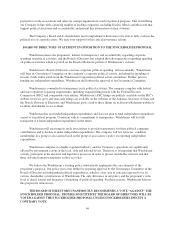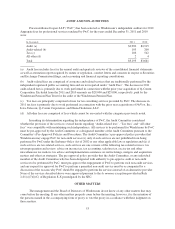Windstream 2011 Annual Report Download - page 52
Download and view the complete annual report
Please find page 52 of the 2011 Windstream annual report below. You can navigate through the pages in the report by either clicking on the pages listed below, or by using the keyword search tool below to find specific information within the annual report.approximately $10 million of which would have represented fully accelerated restricted shares. Other senior
executives would have received fully accelerated vesting of restricted shares worth between $1.4 and 3.4 million
apiece.
The vesting of equity awards over a period of time is intended to promote long-term improvements in
performance. The link between pay and long-term performance can be severed if awards pay out on an
accelerated schedule.
We urge you to vote FOR this proposal.
BOARD OF DIRECTORS’ STATEMENT
IN OPPOSITION TO THE STOCKHOLDER PROPOSAL
Windstream maintains an equity-based compensation program for executive officers that is designed to
provide long-term incentives, to better align the interests of executives with stockholders, and to provide a
retention incentive. For the reasons outlined below, we believe this proposal would conflict with and potentially
undermine these objectives of our equity-based compensation program.
We believe the following design features of our equity compensation program adequately address the
concerns raised by the proponent and render adoption of the proposal to be unnecessary:
• No equity awards vest solely upon signing, receipt of shareholder approval, or consummation of a
change-in-control transaction (i.e., no single-trigger vesting);
• All awards to senior executives have a double-trigger vesting provision, which means vesting does not
occur unless both (1) the change-in-control transaction is consummated and (2) the executive’s
employment is terminated following the transaction. Additionally, the first trigger is tied to
consummation (and not signing or shareholder approval) of a change-in-control transaction;
• No awards vest unless the executive’s position is eliminated in a qualified manner (i.e., termination by
the company without cause, or resignation by the executive for good reason); and
• No awards contain a window period provision that vest the award if the executive resigns within a
specified time period following closing of a change-in-control transaction.
Windstream also believes that it is appropriate for equity-based compensation, including performance-
based equity awards, to vest under this qualified double-trigger framework. It is also not feasible or practicable to
convert performance-based awards into equity awards of the acquiror as part of a change-in-control transaction,
as the performance-based metrics no longer exist once Windstream is acquired and integrated into the acquiror’s
operations. Additionally, in most change-in-control transactions, senior executive positions of the target company
are eliminated as duplicative following the closing of the transaction. If compensation programs are not properly
designed, the risk of loss of a substantial portion of executive compensation can work to discourage management
from pursuing the best alternatives for creating long-term value for shareholders, including a potential
change-of-control transaction, while encouraging pursuit of alternatives more likely to result in longer term
employment of the executive team. Due to this potential conflict, we believe that well-designed
change-in-control arrangements are an important measure to align management’s interests with stockholders. The
conflict is potentially greater at Windstream due to the substantial amount of merger and acquisition activity that
occurs in our sector, as well as Windstream’s practice of allocating a substantial percentage of each executive’s
annual total direct compensation to performance-based equity compensation.
One unintended consequence of adopting the proposal would be to undermine the retention incentive of
equity awards, as management would face the prospect of forfeiture of all or a substantial portion of their equity
awards in the event of a change-in-control. The need for this retention incentive is heightened during the
pendency of a change-in-control, as a target company needs a motivated executive team to continue to operate
the business during the period between signing and closing. The need for this retention incentive is especially
great in Windstream’s industry due to the significant time periods that can elapse before obtaining regulatory
approvals for a transaction.
46
























